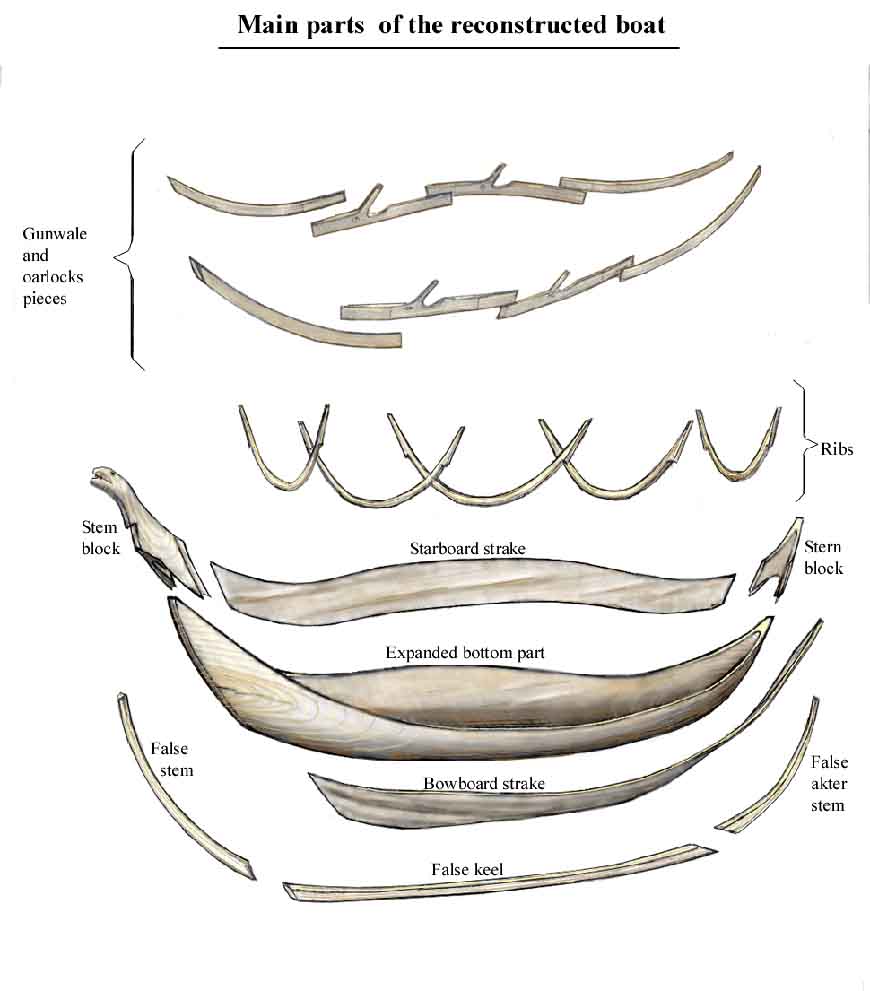
| <<BACK | Foteviken | Sewn boats | Tuna boat | Links | Contact info | FORTH>> |
| Vodlosjorka at Foteviken | Vodlosjorka in Carelia | Kola shnjaka - a bigger sewn ship | Mirror for this site |
Reconstruction
Original Tuna boat was so badly preserved that it was hard to judge about its lines, shape of stems and gunwales. The only hope was to acquire some "feeling" of its "logic", from reconstruction work, by following ancient technique as closely as possible. Then material dimensions themselves can decide a boat's lines. First of all shape of expanded bottom part is important -- on one hand, it almost completely depends on the trunk's dimensions and expanding technique, on the other hand it influences the boat's lines more then any other part. It looked logical to carve stems as high as trunk thickens allowed, i.e. 45-55cm, and make the opening at the top as narrow as hollowing with an adz would permit, (chosen to be 20cm amidships). This opening had to widen towards the ends so as to reach down till half trunk's thickens at some 70-80cm before the ends After expanding it became only 20cm deep amidships, stems being some 60cm high regarding the natural bend of the trunk. All these considerations apply to any expanded dugout, for example, dimensions appear to be quite similar with aspering bottom in Finland. But, unlike the aspering, Tuna boat had quite wide strakes -- almost 30cm amidships -- so wide a plank would reach quite high at a stem end when bent into its shape and applied to a side of the bottom part; unless its width was reduced a lot at the end. But if one had carved a wide plank with an axe, he would certainly not feel like cutting it narrow later, he would rather spare every inch of it! So these material dimensions indicate with some probability, that the boat had high, upward pointed stem ends. Then, one can reliably judge about possible position of oarlocks on the gunwale by preserved bunks.

|
Still, many details remain questionable, and the solutions in the boat built must not be taken for a gospel truth. Design of stem blocks and gunwales is especially doubtful, as they were rotten away completely; if we compare them to similar archaeological boat finds , stem blocks would look credible enough, though they could be smaller and less prominent; as for continuous gunwales -- they are probably a conjecture, original could have just separate oarlock pieces sewn to the upper edge of the strakes. As a matter of fact, experimental planks for the replica strakes were so weak, leaving no choice as to reinforce them with strong continuos gunwale. This does not even agree with the ancient "logic", when a boatbuilder tired to make boat pieces as few as possible, having less joints and seams. He would carve large parts of complex shape out of one piece -- putting of plenty small and simple pieces together is a more modern way.
There was some question with ribs -- except for treenails, going through false keel, bottom and each rib no attachments to the boat's hull were found. In the reconstruction upper ends of each rib are shaved into thin wedge-like shapes, which are pressed between sewn gunwale/oarlock and the strake; a common solution both in Viking time vessels and more modern boats(e.g.in NW Russia). While strakes were sewn to their place, some of the stitches were also put so as to lash the ribs to the hull. Ribs were made of especially found curved pieces of juniper, at most 5 cm thick; these pieces were extremely difficult to find all juniper stems have some holes and caverns inside, so 5 cm thick ribs are quite weak. It was probably just the same in the original boat, some caverns are visible in her ribs, too, they probably existed from the beginning, and were not rotten through in the grave. To give the boat sufficient transverse stiffness rowing bunks were pressed in with considerable force, widening the whole boat for 3-4 centimeters, and fixed in this position by small treenails. To prevent them from going further down under the weight of rowers, especial supporting pins, like "sneill" in Norwegian boats, were inserted under the bunks.
Those dimensions of the original boat, which were reliably reconstructable -- such as spaces between ribs, or dimensions of smaller parts, were followed precisely. Other parts underwent visible deformation in the grave, and their dimensions were chosen accordingly to the common sense and the logic of technique. Width and depth of the bottom part, for instance, were decided by trunk diameter and achievable expanding rate, the bottom is possibly somewhat (5-10cm) wider and 2cm deeper then original, proportions held exactly. It was easiest thing to reduce its width by cutting edges, but it would be against all senses, an ancient boatbuilder would rather give his own hand to cut. Consequently the whole boat might be a little wider and deeper then it was, but, in eyes of the original builders it would probably be an achievement rather then a fault.
| <<BACK | Foteviken | Sewn boats | Tuna boat | Links | Contact info | FORTH>> |
| Vodlosjorka at Foteviken | Vodlosjorka in Carelia | Kola shnjaka - a bigger sewn ship | Mirror for this site |